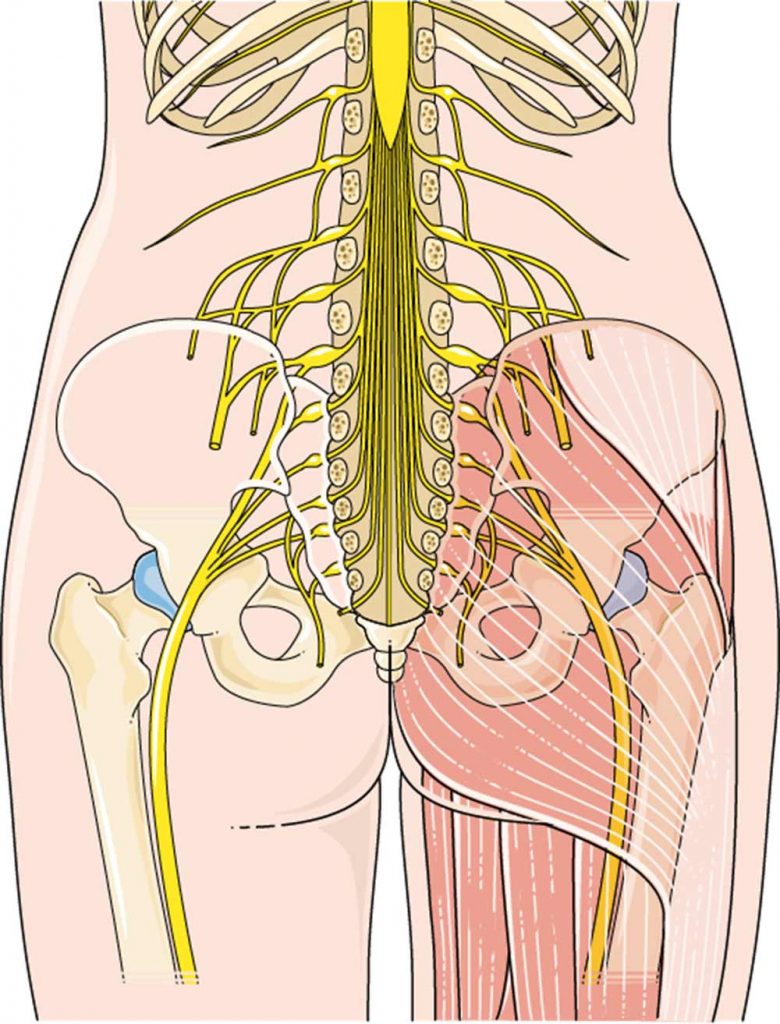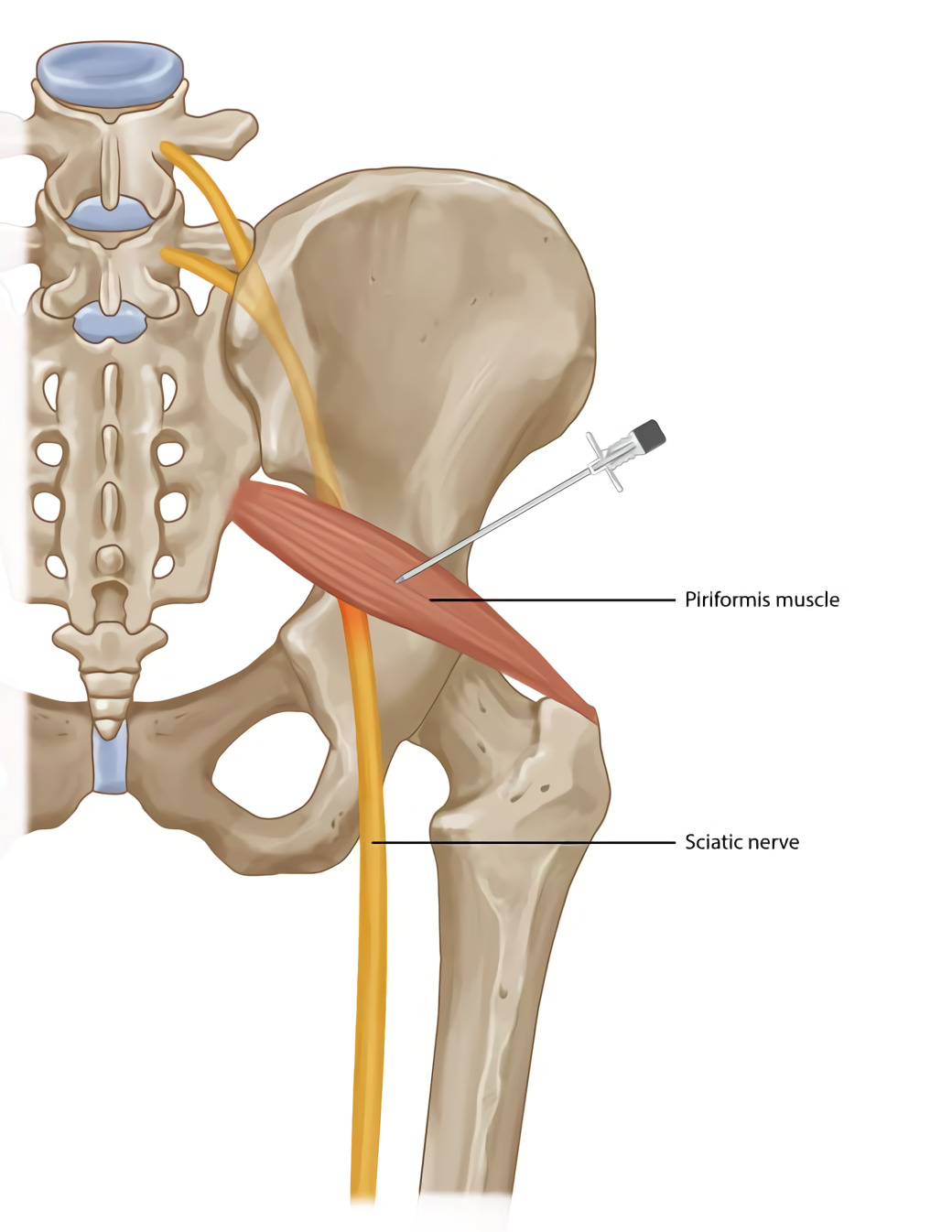- What is the Sciatic Nerve?
- What is Sciatica?
- What is Piriformis Syndrome?
- What is the Difference between Sciatica and Piriformis Syndrome?
- Differentiating Piriformis Syndrome from Other Sciatic Nerve Conditions
There are differences between piriformis syndrome vs. sciatica, even though the symptoms are similar. The reason they are similar is due to the fact the piriformis muscle may irritate or compress the sciatic nerve, causing pain similar to sciatica pain that is due to other medical conditions, like disc herniation or spinal stenosis. It usually takes a physician’s assessment to determine the specific diagnosis.

What is the Sciatic Nerve?
The sciatic nerve is a large nerve that branches out at the lower back. It runs through each hip and buttock and down the thigh and leg to the foot. When the sciatic nerve is compressed, inflamed, irritated, or injured, pain frequently radiates down the nerve. The pain originates in the lower spine (lumbar spine) where the nerve begins.
What is Sciatica?
Sciatica is a set of symptoms that occur when the sciatic nerve is irritated, compressed, or inflamed. It is usually caused by the compression or impingement of nerve roots due to spinal degeneration. The degeneration could be due to conditions that include but are not limited to:

- Herniated spinal disc
- Bulging disc
- Bone spur
- Spinal stenosis (narrowing of the spine canal)
- Tumor
- Spondylolisthesis
- Injury to the spine
- Infection
The pain experienced depends on the specific nerve root impacted. It can be intermittent or constant but often feels like a sharp pain shooting down the leg from the lower back. Other symptoms include weakness in the leg and foot, numbness, or tingling in the leg’s back.
What is Piriformis Syndrome?
Piriformis syndrome is a condition in which the piriformis muscle compresses the sciatic nerve. The piriformis muscle is in each buttock and attaches the sacrum to the top of the thigh bone. The piriformis muscle and the sciatic nerve are in close alignment.
Due to the contractions or spasms of the piriformis muscle, sciatic nerve pain can begin. When the muscle contracts, spasms, or experiences other issues, it can compress or irritate the sciatic nerve. The pain associated with piriformis syndrome is typically felt more in the buttock and hip.

What is the Difference between Sciatica and Piriformis Syndrome?
The main differences between sciatica versus piriformis syndrome are:
- Where the pain is typically felt – buttock and hip for piriformis syndrome, while leg pain may radiate down to the toes for sciatica
- What causes the pain – the piriformis muscle is causing the pain by impacting the sciatic nerve in piriformis syndrome, while the pain of sciatica is one symptom of a particular medical condition creating a set of symptoms
- What causes more pain – pain increases while sitting for a prolonged period in piriformis syndrome, while raising the leg (the one impacted) while lying down may cause pain with sciatica
Differentiating Piriformis Syndrome from Other Sciatic Nerve Conditions
The symptoms of piriformis syndrome are similar to the symptoms of sciatica. Since sciatica is a set of symptoms, common questions are similar to this one: How do I know if I have piriformis syndrome vs herniated disc since the symptoms are similar?
A herniated disc is first diagnosed by performing simple tests like the LaSeque test. This sciatica test requires the patient to lie on his/her back, and the doctor raises the impacted leg until the pain begins. If pain occurs when the leg is raised to a 30-70 degree angle, it is a strong indication of a lumbar disc herniation. Also, imaging tests, like an MRI or CT scan, can show a herniation and the impacted nerves.
Piriformis syndrome is more difficult to diagnose. When the physician orders an MRI, it is to eliminate other conditions, like a lumbar disc herniation. The primary diagnostic method is having the patient move the hips and legs to identify where the pain occurs. If it is in the lower back and buttocks only, it may be piriformis syndrome. If the pain is in the lower extremity, it is likely sciatica.

Important to See a Doctor
Piriformis sciatica pain can feel as intense as the pain of sciatica that is due to other medical conditions. It is important to see a doctor. The symptoms of piriformis syndrome vs. sciatica may be similar, but the treatments are normally quite different. There is also the danger of making symptoms worse by doing the wrong things.
